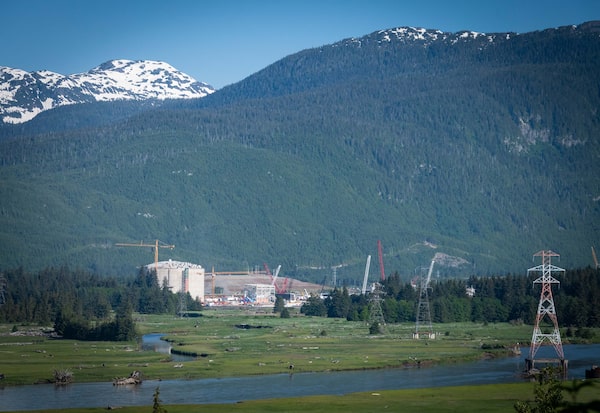
Looking across Kitimat River towards LNG Canada's storage tank.Kristopher Grunert/The Globe and Mail
By early next year, the average British household could be paying almost €4,300 a year – about $6,600 – for electricity and home heating, according to an estimate released on Tuesday by the consulting firm Cornwall Insight. That’s a nearly fourfold increase in the space of a little more than a year and a half. It’s the equivalent of the average Canadian family paying $550 a month for hydro.
Britain hasn’t seen anything like this since the U-boats tried to starve and freeze it into submission. The Bank of England last week said that the country is headed for stagflation – the double whammy of inflation and recession – and that it will last until 2024, powered in no small part by the sudden spike in gas prices.
All across Europe, variations of this story are playing out to one degree or another, as the continent tries to figure out how to kick its addiction to Russian gas – as Russian President Vladimir Putin, using one of his few economic weapons, constricts gas supplies.
But a crisis for some is an opportunity for others. If it embraces opportunity, Canada could be among the second group.
This country is one of the world’s largest producers of natural gas. Problem: Canada currently has no capacity to export gas anywhere other than the United States. And the U.S. is the world’s largest gas producer and, as of this year, the largest exporter.
Back in 2016, the U.S. had almost no facilities that could export liquefied natural gas (LNG). A lot has changed in six years. As of last month, the U.S. Energy Information Agency (EIA) estimated the U.S. had the ports and facilities to export as much as 13.9 billion cubic feet per day. Nearly all of that capacity is being used, mostly for exports to Europe, where LNG earns top dollar. Between the first half of 2021 and the first half of 2022, U.S. LNG exports increased by 12 per cent.
And Canada? Canada had no LNG export capacity in 2016. And Canada has no LNG export capacity today.
This country is still profiting somewhat from the European crisis, since as American producers push as much gas as possible onto ships bound for Europe or Asia – where prices are much higher – they are in part backfilling with imports of Canadian gas, via pipeline.
But Canadian gas is, for now, still largely landlocked in North America. The Americans are taking advantage of their export capacity to benefit from the European attempt to find replacements for Russian gas; Canada is currently only able to benefit to the extent that American producers need additional (and relatively low-priced) Canadian supply.
Predicting the future with any certainty is impossible; until this spring, the assumption was that Asia would steadily switch from coal to gas for electricity generation, because gas was cleaner, and relatively cheap. It is no longer cheap. But the magic of the market is that as supply constraints push up prices, that brings more suppliers to market.
There are already investors willing to bet that Canada could be one of those major new LNG suppliers.
The $40-billion LNG Canada project, with an export terminal in Kitimat, B.C., at the end of the Coastal GasLink pipeline, aims to be up and running by 2025. A $5.1-billion project known as Woodfibre – with gas liquefaction powered by clean hydro – wants to be operating by 2027. On the East Coast, the Spanish energy firm Repsol is looking at creating an LNG export terminal at an existing facility in Saint John, N.B. – though it first has to deal with the issue of moving the gas from the wells to the Atlantic. It’s an engineering and financial challenge, but it may be even more of a political challenge. Environmental groups are lining up to oppose the plan.
In the face of a big and potentially enduring energy shortage in Europe, large pools of investment capital are looking at where they can most profitably invest tens of billions of dollars to find and ship long-term supplies of relatively cheap and – compared to coal – less carbon-intensive natural gas.
Canada would be wise to position itself as a potential beneficiary of these investments decisions and not, as it has mostly been until now, a bystander.
Keep your Opinions sharp and informed. Get the Opinion newsletter. Sign up today.